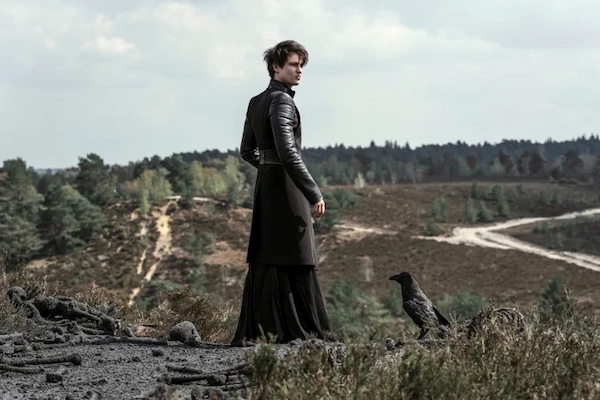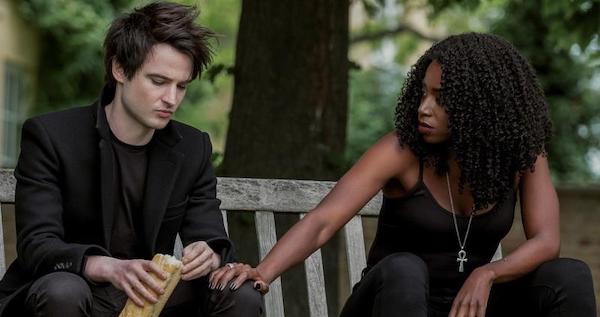WATCH CLOSELY: “The Sandman” Is Deliriously Beautiful Art
By Peg Aloi
Creator Neil Gaiman has said for years that he didn’t want an adaptation to be made unless the creative team could do the original justice. Well, justice has been done: this is a seismic cultural event.

Tom Sturridge in a scene from Netflix’s The Sandman. Photo: Netflix
I read the Sandman comics back in the ’90s, slim paperbacks that collected the original paper comics into several volumes. I started with Season of Mists (the first line of John Keats’ “An Ode to Autumn”) and worked my way through the series steadily but slowly, savoring their narrative depth and gorgeous visual artistry. I found the stories haunting, sensual, and provocative. They were the zenith of what graphic novels could be and many critics agreed — these were intricate and erudite but accessible reading experiences. Much of their charismatic appeal stemmed from the dark brilliance of creator Neil Gaiman, a master of modern horror and fantasy. He is also a cool guy. Back in the day I got to interview him for the Boston Phoenix, when he came to Boston to do a reading for a fundraiser for comic artists who were fighting censorship. “Bless comics,” he said, “they are a gutter literature.” For many years fans wondered if there would ever be a film or television adaptation. Many were fearful, assuming there was never going to be a way to evoke Sandman’s complexity and beauty.
The Sandman’s first season, 10 episodes, has just dropped on Netflix. I know the service’s practice of releasing an entire season of a series all at once is a source of excitement and joy for many viewers, but don’t be surprised if you find yourself wanting to take your time with this dazzling story. The creative team at the helm of the adaptation is top notch and well chosen. The show was developed by Gaiman, with David S. Goyer (The Dark Knight) and Allan Heinberg (Wonder Woman); the trio also leads the writing team. The directing team is led by Mike Barker (English director known for Broadchurch, Fargo, and The Handmaid’s Tale, soon to begin its fifth season) and Jamie Childs (His Dark Materials), with additional writers and directors added as the episodes progress. The production is notable for its racial and gender diversity in casting (as well as in writing and directing), a nod to changing norms in storytelling and audience expectations. And there are some outstanding cameos.
The framework of the original story is solid: Dream, aka Morpheus (Tom Sturridge, an English actor who first impressed me as John Everett Millais in Effie Gray) is one of The Endless: a group of immortal siblings who rule over the mortal realm. There are a number of them: Death, Desire, Despair, Delirium, Destiny, and Destruction. We only meet some of The Endless during the first season. Each of them inhabits a realm uniquely designed for them; Dream’s ethereal realm is known as The Dreaming, a shadowy and beautiful place of cathedrals, meadows, caves, and vast mountains. The land is peopled by assorted odd characters including Cain and Abel and their pet gargoyle. Dream’s story arc begins with a stunning plot twist: he has been imprisoned for a hundred years by an occultist (Charles Dance) who had been hoping to trap his sister, Death (Killing Eve’s Kirby Howell-Baptiste), in order to bring back his son, who was killed in the Great War in 1916. Dream’s imprisonment triggers a pandemic of “sleeping sickness” (a parallel to the wartime influenza pandemic, perhaps). When he finally returns to his realm he finds it all but destroyed. The setting as well as many of the characters are unapologetically English, and much of the human-centered action takes place in London, though the locations do some jumping around.
For example, Buffalo, New York, is the home of art and antiquities dealer Ethel Cripps (Joely Richardson in a juicy role), mother to occult magician and madman John Dee (the brilliant David Thewlis, of HBO’s Landscapers). We see Dee, recently escaped from a psychiatric facility and possessed of an occult talisman his mother procured, wreaking havoc on the customers in a diner, forcing them to tell the truth and then follow their innate impulses toward destructive behavior. There’s a “cereal” convention (for serial killers) taking place at a hotel in Georgia, one of many locations where we see The Corinthian (The Fugitive’s Boyd Holbrook), a charming sociopath who moves easily between the Endless realms and the human world, smiling and bringing exquisite mayhem everywhere he goes. Then there’s Hell, where Dream must face off (in a stunning sequence) with his nemesis Lucifer Morningstar, played by the excellent Gwendoline Christie. Lucifer is one of several major roles originally imagined as male in the graphic novel series (and whose face and fashion sense often looked startlingly like David Bowie, the 20th-century icon of androgyny). Played by Christie, Lucifer is elegant, vengeful, and perversely cruel.

Tom Sturridge and Kirby Howell-Baptiste in a scene from The Sandman. Photo: Netflix
There are other casting transformations. Johanna (originally John) Constantine, an occult detective from Liverpool, appears throughout the DC Comics universe. Played by Dr. Who’s Jenna Coleman, Johanna is a bit less rumpled than John (whose ubiquitous wrinkled tan trench coat is replaced by a tasteful white wool coat with a silver buckle). But her personal life is a bit of a shambles. Lucienne (originally Lucien), the head librarian in The Dreaming, and Dream’s unofficial advisor, is played by Vivienne Acheampong. It’s impossible to overstate the excellence of these three performances; the presence of more female characters is a good fit for this updated version of the series. Also: Lucien is a white man in the graphic novel, and Lucienne is a Black woman: a daring yet wholly appropriate casting choice. Similarly, Dream’s sister Death is played by the Black actress Kirby Howell-Baptiste, and she provides a moving and evocative portrait. The casting is a radical departure from the pale-faced goth princess familiar to Sandman readers, but Howell-Baptiste stuns in the role, bringing subtle wit and humor to the dual nature of Death’s job — life-affirming yet pragmatic about her constant visitations to mortals whose time has run out. Another major character featured toward the end of this first season, Rose Walker, was also originally white, and is now Black (played by impressive newcomer Vanesa Samunyai). I applaud this reimagining and the richness it brings to the series.
In addition to adapting the characters in unexpected yet very effective ways (though it took a while for Patton Oswalt’s voicing of Matthew the Raven, Death’s familiar and psychopomp, to grow on me), the Netflix series also captures the original graphic novel’s art and style very effectively. I have not read the graphic novels in a very long time, but I found myself gasping aloud multiple times when the visionary cinematography perfectly rendered a panel I remembered from the comic. The production design by Jon Gary Steele is thrilling, as is the set design by art directors Lydia Farrell (who worked on Outlander with Steele) and Nicki McCallum (Cloud Atlas, Monarch of the Glen), and costumes by Sarah Arthur (Dracula). I expect a lot of buzz around the show’s design elements come next year’s award season.
This adaptation has been such a long time coming it’s fair to say that many Sandman fans didn’t truly believe it was ever going to happen. Gaiman has said for years that he didn’t want an adaptation to be made unless the creative team could to the original comics justice. Well, justice has been done: this is a seismic cultural event, and it comes at just the right time, given our contemporary surreal hellscape of disease, climate disasters, violence, corruption, and other woes. Sleeplessness and anxiety are the new normal, so what could be more reassuring than a work of art reminding us how central dreams are to our lives — as a primal source of human hope and renewal.
Peg Aloi is a former film critic for the Boston Phoenix and member of the Boston Society of Film Critics. She taught film studies in Boston for over a decade. She writes on film, TV, and culture for web publications like Time, Vice, Polygon, Bustle, Mic, Orlando Weekly, and Bloody Disgusting. Her blog “The Witching Hour” can be found on substack.
Tagged: Kirby Howell-Baptiste, Neil Gaiman, Peg Aloi, The Sandman
